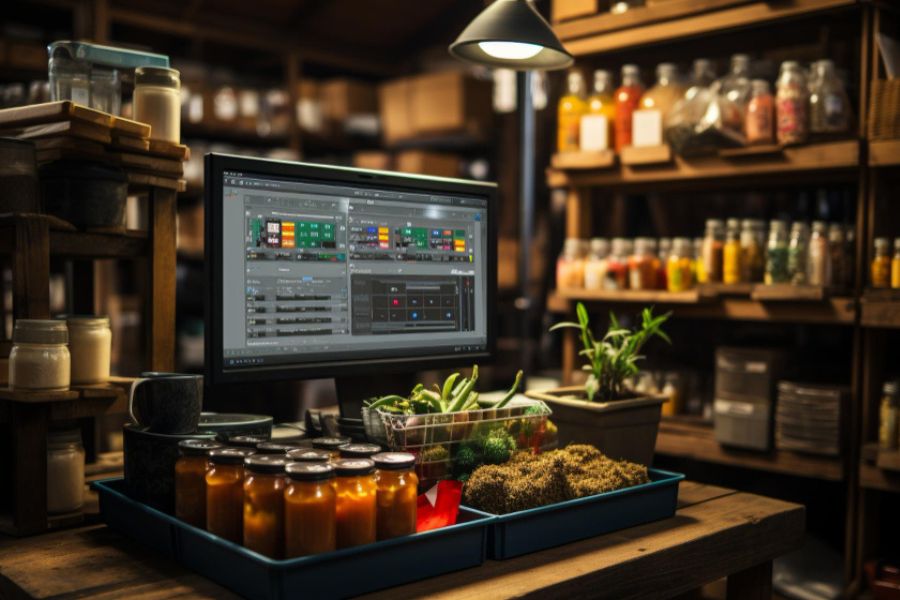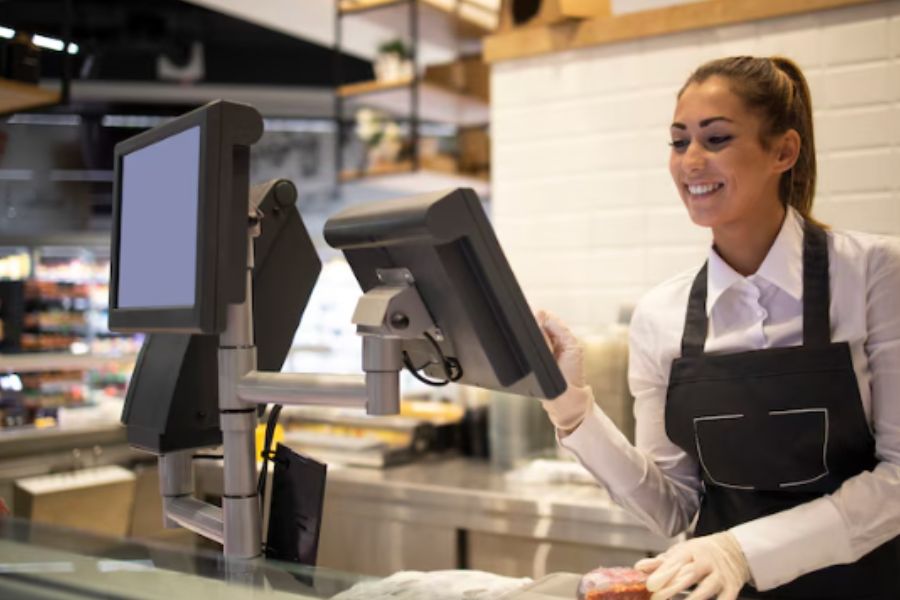POS systems can benefit grocery stores immensely, but there’s a catch. While they promise efficiency and improved customer satisfaction, grocery store point of sale software comes with unique challenges. Technical issues and integration hurdles often disrupt operations. Data accuracy is another concern that can impact inventory management. Additionally, security issues pose significant risks. Navigating these complexities is crucial for store owners and managers aiming to leverage POS systems effectively. Let’s explore these common challenges in detail to better understand how to address them.
Highlights
- Managing perishable inventory while ensuring minimal waste and stockouts can be a constant struggle for grocery stores.
- Grocery store operators often face challenges with POS system downtime, integration issues with other software, and the need for thorough staff training.
Challenges Faced in Grocery Store Management
Managing a grocery store involves various challenges that can impact efficiency and profitability. Let’s explore how issues in inventory, costs, customer satisfaction, and staff training affect daily operations.
- Inventory Management Inefficiencies
Grocery stores often struggle with inventory management, leading to stockouts and overstock situations. According to a report by Retail Systems Research, 65% of grocery retailers cite inventory accuracy as a significant challenge.This issue affects their ability to meet customer demand and maintain profitability. Adopting grocery store point-of-sale software can help address these inefficiencies by providing real-time inventory tracking and analysis.
- High Operational Costs
Grocery stores operate on thin profit margins, and high operational costs can quickly erode profitability. Expenses related to labor, utilities, and rent must be carefully managed. Effective systems and processes can help control these costs and improve the store’s bottom line. Grocery store point-of-sale software can automate many tasks, reducing labor costs and improving overall efficiency.
- Maintaining Customer Satisfaction
Customer satisfaction is crucial in the highly competitive grocery market. Long checkout lines, stockouts, and poor customer service can drive customers away. Stores must focus on providing a smooth shopping experience, from ensuring product availability to offering quick and efficient service at the checkout. Advanced grocery store point-of-sale software can help manage customer queues, process transactions faster, and provide better service.
- Data Security Concerns
Data breaches are a significant risk for grocery stores, especially with the sensitive information handled at the point of sale. Grocery store point-of-sale software must include robust security measures to protect customer data. This includes encryption, regular software updates, and compliance with data protection regulations.
Common Challenges in Operating Grocery Store Point of Sale Software
Operating grocery store point-of-sale software can be complex, presenting challenges in technical reliability, system integration, data management, security, and user adoption. We’ve list oued the key issues to that you should be aware of.
Technical Issues and Downtime
- System Disruptions
Technical bugs and system crashes can significantly disrupt store operations, especially during peak hours. These disruptions can lead to long checkout lines, decreased customer satisfaction, and even lost sales. Proactive maintenance, regular software updates, and having a responsive technical support team can minimize these issues.
- Connectivity Problems
POS systems often rely on stable internet connectivity for real-time data updates and processing. Connectivity issues can result in slow transaction processing, inability to access cloud-based data, and interrupted service. Investing in a robust network infrastructure, including backup internet solutions, can help mitigate these risks.
Integration with Other Systems
- Data Inconsistencies
Inaccurate data synchronization between the POS system and other systems (like inventory and accounting) can lead to discrepancies. For example, sales data not reflecting in the inventory system can result in stockouts or overstocking. Utilizing middleware or integration platforms can help ensure seamless data flow and consistency across all systems.
- Operational Inefficiencies
Lack of integration can force staff to manually enter data into multiple systems, which is time-consuming and error-prone. Automating data transfers and ensuring systems are well-integrated can reduce manual work, improve accuracy, and enhance overall efficiency.
Data Accuracy and Management
- Manual Entry Errors
Human error during manual data entry can lead to significant issues such as incorrect pricing, inventory mismanagement, and flawed sales reports. Implementing automated data capture technologies, such as barcode scanners or RFID systems, can reduce manual errors and improve data accuracy.
- Outdated Information
Making decisions based on outdated data can affect inventory management, pricing strategies, and customer satisfaction. Real-time data synchronization and regular data audits are essential to ensure that decision-makers have access to the most current information.
User Training and Adoption
- Resistance to Change
Employees accustomed to older systems or manual processes may resist switching to a new POS system. This resistance can be mitigated through comprehensive training programs that highlight the benefits of the new system and provide hands-on experience.
- Lack of Technical Proficiency
Not all staff may be tech-savvy, which can hinder the effective use of advanced POS systems. Providing continuous training and easy-to-access support resources can help staff develop the necessary skills to use the system efficiently.
Security Concerns
- Data Protection
Grocery stores handle sensitive customer data, including payment information. Ensuring data security through measures like encryption, secure payment gateways, and regular security audits is crucial to protect against data breaches and maintain customer trust.
- Compliance with Regulations
Compliance with data protection regulations (such as GDPR, CCPA) is not only a legal requirement but also critical for maintaining customer trust. Regularly updating the POS system to comply with these regulations, conducting security audits, and training staff on data protection practices are essential steps.
Inventory Management
- Stockouts and Overstock Situations
Inaccurate inventory data can lead to stockouts, resulting in lost sales, or overstock situations, increasing holding costs. Integrating real-time inventory management with the POS system helps automate tracking and replenishment, ensuring optimal stock levels.
- Manual Tracking Issues
Relying on manual inventory tracking methods can be inefficient and prone to errors. Implementing automated systems, such as barcode scanning and RFID, ensures accurate and real-time inventory updates.
Compliance with Regulations
- Health and Safety Standards
Grocery stores must comply with various health and safety standards, including food safety regulations. Providing that the POS system supports these compliance requirements, such as tracking expiration dates and managing recalls, helps avoid legal issues and ensures customer safety.
- Taxation Compliance
Accurate tax calculations and compliance with local tax laws are essential. Regularly updating the POS system with the latest tax rates and conducting audits can help ensure accurate taxation and avoid penalties.
Customer Experience
- Checkout Efficiency
The speed and reliability of the POS system directly impact the checkout process. Slow or inefficient systems can lead to long wait times, frustrating customers and deterring repeat business. Optimizing system performance, using high-speed hardware, and streamlining the checkout process are critical for a positive customer experience.
- Payment Options
Offering various payment options, such as digital wallets, contactless payments, and traditional methods, caters to customer preferences and enhances convenience. The POS system’s ability to efficiently handle multiple payment types is vital for improving customer satisfaction.
Best Practices for Overcoming Challenges with Grocery Store Point of Sale Software
Regular System Updates and Maintenance
Keeping POS software up-to-date is essential for maintaining compatibility with evolving hardware and software technologies. This proactive approach helps mitigate technical issues and ensures smooth operations.
Furthermore, routine maintenance checks can preempt system downtimes and glitches. For example, ConnectPOS automates updates and maintenance, keeping the system in optimal condition and reducing the burden on IT staff.
Comprehensive Staff Training Programs
Investing in thorough training programs for staff can significantly enhance the effectiveness of the POS system. Well-trained employees are less likely to make errors, thereby improving overall store performance. ConnectPOS offers training modules that are specifically designed for various roles within the store, making the learning process more relevant and engaging.
Plus, continuous education and support keep staff familiar with new features and functionalities, which can boost their confidence and operational efficiency.
Implementing Robust Security Protocols
Protecting sensitive customer information is paramount in today’s retail environment. Strong security measures, such as encryption and secure payment processing, are fundamental to safeguarding data against breaches and fraud. ConnectPOS integrates these security features to provide a robust defense.
Moreover, adhering to data protection regulations, such as GDPR and CCPA, is necessary to avoid legal penalties. ConnectPOS offers tools and protocols to help stores comply with these regulations, thereby ensuring customer trust and legal compliance.
Ensuring Seamless Integration with Other Systems
Integration with inventory management, accounting, and CRM systems is crucial for maintaining data consistency and operational efficiency. ConnectPOS supports extensive integration capabilities, simplifying synchronization with various business systems. This interconnected approach reduces the need for manual data entry and reconciliation, which minimizes errors and saves valuable time.
Moreover, seamless integration enables more accurate and timely information flow, enhancing decision-making processes across the organization.
Utilizing Data Analytics for Informed Decision-Making
Leveraging data analytics can transform store management by providing real-time insights. ConnectPOS includes powerful analytics tools that track sales trends, inventory levels, and customer behavior.
These data-driven insights enable managers to make informed decisions that enhance inventory management, pricing strategies, and promotional campaigns. As a result, stores can achieve increased profitability and higher customer satisfaction through more targeted and effective strategies.
Engaging with Customer Feedback to Improve POS Experience
Incorporating customer feedback is a strategic way to refine the POS system’s functionality and user experience. ConnectPOS facilitates the efficient collection and analysis of customer feedback, providing actionable insights.
By addressing customer concerns and preferences, stores can significantly enhance the shopping experience. This customer-centric approach ensures that the POS system evolves to meet customer needs effectively, fostering loyalty and satisfaction.
ConnectPOS is a leading point of sale solution designed to meet the unique needs of grocery stores. It offers comprehensive features such as automated updates, robust security protocols, seamless integration capabilities, and powerful analytics tools.
With focuses on enhancing operational efficiency and customer satisfaction, ConnectPOS provides a reliable and efficient system for managing daily store operations. Its user-friendly interface and dedicated support make it an ideal choice for grocery retailers looking to optimize their POS systems.
FAQs: Common Challenges when Operating Grocery Store Point of Sale Software
1. What do grocery stores face the main challenges in managing inventory with traditional methods?
Grocery stores often face significant challenges in managing inventory with traditional methods due to the labor-intensive and error-prone nature of manual processes. Traditional methods, such as manual counts and paper records, can lead to inaccurate inventory levels, resulting in stockouts or overstock situations. These inaccuracies can negatively impact customer satisfaction and profitability. Additionally, traditional methods lack real-time tracking capabilities, making it difficult to respond promptly to inventory needs and trends.
2. How can a grocery store POS system help reduce billing errors and improve efficiency?
A grocery store POS system can greatly reduce billing errors and improve efficiency by automating the transaction process. The system ensures accurate pricing by automatically applying discounts and promotions, reducing the likelihood of human error. POS systems also streamline the checkout process with barcode scanning and digital payment integration, speeding up transactions and minimizing customer wait times. Furthermore, POS systems provide real-time data updates, which help store managers monitor sales and inventory levels, allowing for better decision-making and resource allocation.
3. Why is it important for grocery stores to offer multiple payment options, and how does a POS system facilitate this?
Offering multiple payment options is crucial for grocery stores to accommodate the diverse preferences of their customers. Customers expect the convenience of paying with credit/debit cards, mobile wallets, and contactless payments in addition to cash. A POS system facilitates this by integrating various payment methods into one platform, allowing for seamless transactions. This not only enhances the customer experience by providing flexibility and convenience but also increases the potential for sales by catering to a wider audience. POS systems ensure secure and efficient processing of different payment types, thereby boosting customer satisfaction and loyalty.
Conclusion
Navigating the complexities of grocery store point of sale software can be daunting, but by understanding and addressing these common challenges, grocery stores can significantly enhance their operational efficiency and customer satisfaction.
For grocery stores aiming to optimize their POS systems and improve their business operations, exploring the features and support offered by solutions like ConnectPOS can be a game-changer. If you’re ready to take your grocery store to the next level, contact us to learn more about how we can help.



